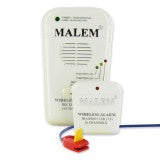Your Cart is Empty

About bedwetting in children
What is a bedwetting alarm and how does it work?
Will alarms work for deep sleepers?
How are parents involved in the bedwetting alarm process?
What are the different types of bedwetting alarms?
What features should I look for when buying an alarm?
Do bedwetting alarms work for adults?

About bedwetting in children
Everyone is born wetting the bed. As children grow and develop, so does their ability to control their bladder. By age 5, the majority of children develop complete urinary control. However, approximately 20% of children don’t and experience bedwetting, or nocturnal enuresis.
A bedwetting child cannot feel the sensation of a full bladder and respond to it. So instead of waking up to go to the bathroom or "holding it in" as the non-bedwetting child does, he/she wets the bed. No one knows exactly why this occurs in some children and not in others. Certainly factors such as deep sleep, small bladder capacity, increased nighttime urine production, constipation and food sensitivities play a part in bedwetting. It seems that these children's nervous systems are "wired differently." In bedwetting children, their brains have to learn what the appropriate response to a full bladder is. This is where the bedwetting alarm is useful.

What is a bedwetting alarm and how does it work?
Bedwetting alarms, or enuresis alarms, are essential in the treatment of bedwetting. Research indicates a 60-80% long-term success rate when used correctly.
A bedwetting alarm is a device that emits an auditory and/or tactile sensation in response to wetness. The alarm is attached to the child's underwear or pajamas in the area that one would expect the first drop of urine to be noticed. When the child wets, the alarm makes a loud noise to alert the child and his/her parents that wetting is occurring. In theory, the child hears or feels this and learns to get out of bed to empty his/her bladder into the toilet.
Gradually, over several months, the child learns to respond to the feeling of a full bladder by "beating" the alarm it goes off. This is a type of behavioral conditioning. It differs from setting an alarm clock to go off at a certain time or by the parents waking the child to use the bathroom. The best type of conditioning is in response to the child's full bladder and urination, which will vary in time from night to night.
Since enuresis alarms are a mainstay in the treatment of bedwetting, it's an easy first step that most parents can take. No prescription is necessary and children over 6 years can learn to respond.

Will alarms work for deep sleepers?
A common myth is that the enuresis alarm is useless in children who are deep sleepers. Although almost all bedwetting children sleep more soundly than their peers who don't regularly wet the bed at night, not all deep sleepers are bedwetters.
For bedwetting deep sleepers, a bedwetting alarm can actually be very effective - but first, with a parent's assistance.

How are parents involved in the bedwetting alarm process?
Initially, the parents play an important part in arousing the sleeping child once the alarm has gone off.
"In my experience, more than three-fourths of these children do not initially awake to the loud (80db) alarm once they are asleep. When they hear the alarm tested while they are awake, they can't believe they could possibly sleep through that loud sound. But, at least initially, this is the case." - Renee Mercer, Enuresis Expert, Pediatric Nurse Practitioner
For this reason, the parents usually will hear the alarm first, even if their room is down the hall. (For those parents that sleep on a different floor than their child, I recommend using a baby monitor or something similar to what you used when your child was an infant.) Once the parent hears the alarm, they should quickly respond to the child. If the child is sitting up or moving in response to the noise, the parent can just remind them what to do next — go use the bathroom. If the child is still sleeping, the parent may need to gently shake them, call their name, turn on the light or do whatever else it takes to wake them.

What are the different types of bedwetting alarms?

What features should I look for when buying a bedwetting alarm?
Because the loud sound is what alerts the parents to assist their child and help them to the bathroom, an auditory alarm is necessary. A vibratory only alarm, which is similar to a pager worn in the underwear, does not allow the parents to help the child respond. Many parents report that their child sleeps through this type of alarm and wakes up wet with no idea of what they could have done differently.
In order to be effective, the alarm has to work 100% of the time:
Some alarms, such as the Malem ones, have a two-step turn-off, preventing accidentally pulling it off. (The alarm sounds, alerting you if the sensor is accidentally pulled from the underwear.) Correct placement on the clothing is necessary so that the alarm can sense the first drop of urine.
"The clothing would have to be saturated with urine before the alarm would respond if the placement is incorrect or if the clothing is too loose fitting. For this reason, boxer shorts or loose fitting pajama bottoms would not be the best choice. Snug fitting panties or briefs are ideal." - Renee Mercer
An alarm with a permanent placement for the urine sensor is another option. The Rodger Wireless Alarm consists of specially designed briefs with the sensor threads sewn in place. The small transmitter is snapped on the waistband and the receiver is plugged into the wall or placed on the nightstand. Once the underwear senses the moisture, the receiver continues to sound until the wall unit is turned off. Someone must get out of bed to attend to this alarm! And why not go to the bathroom while you're up?

Do bedwetting alarms work for adults?
For young adults who have never obtained nighttime dryness (primary enuresis), alarms can be effective. They typically take longer to work than they do on children, but with diligence, bedwetting alarms can help you achieve dryness. For older adults who recently began wetting the bed (secondary enuresis), alarms won’t be effective. Enuresis alarms work by helping to teach the brain to awaken to the feeling of a full bladder. If you have already learned that skill (meaning you have been dry at night for many years), alarms will not change nighttime wetting. Instead, Kegel exercises or other incontinence treatments are your only options to prevent nighttime (and probably daytime) wetting.